tow FIAT IDEA 2008 1.G Owner's Manual
[x] Cancel search | Manufacturer: FIAT, Model Year: 2008, Model line: IDEA, Model: FIAT IDEA 2008 1.GPages: 210, PDF Size: 3.64 MB
Page 137 of 210
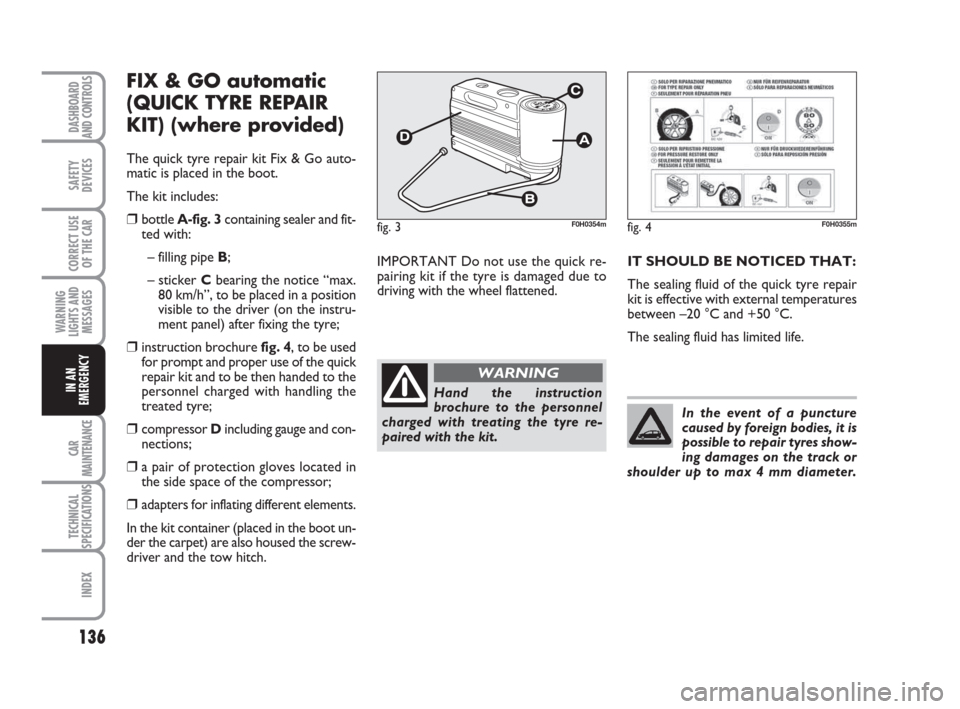
136
CAR
MAINTENANCE
TECHNICAL
SPECIFICATIONS
INDEX
DASHBOARD
AND CONTROLS
SAFETY
DEVICES
CORRECT USE
OF THE CAR
WARNING
LIGHTS AND
MESSAGES
IN AN
EMERGENCY
FIX & GO automatic
(QUICK TYRE REPAIR
KIT) (where provided)
The quick tyre repair kit Fix & Go auto-
matic is placed in the boot.
The kit includes:
❒bottle A-fig. 3containing sealer and fit-
ted with:
– filling pipe B;
– sticker Cbearing the notice “max.
80 km/h”, to be placed in a position
visible to the driver (on the instru-
ment panel) after fixing the tyre;
❒instruction brochure fig. 4, to be used
for prompt and proper use of the quick
repair kit and to be then handed to the
personnel charged with handling the
treated tyre;
❒compressor Dincluding gauge and con-
nections;
❒a pair of protection gloves located in
the side space of the compressor;
❒adapters for inflating different elements.
In the kit container (placed in the boot un-
der the carpet) are also housed the screw-
driver and the tow hitch.IMPORTANT Do not use the quick re-
pairing kit if the tyre is damaged due to
driving with the wheel flattened.
fig. 3F0H0354mfig. 4F0H0355m
Hand the instruction
brochure to the personnel
charged with treating the tyre re-
paired with the kit.
WARNING
IT SHOULD BE NOTICED THAT:
The sealing fluid of the quick tyre repair
kit is effective with external temperatures
between –20 °C and +50 °C.
The sealing fluid has limited life.
In the event of a puncture
caused by foreign bodies, it is
possible to repair tyres show-
ing damages on the track or
shoulder up to max 4 mm diameter.
133-160 idea GB 1 ed 10-07-2008 8:30 Pagina 136
Page 145 of 210
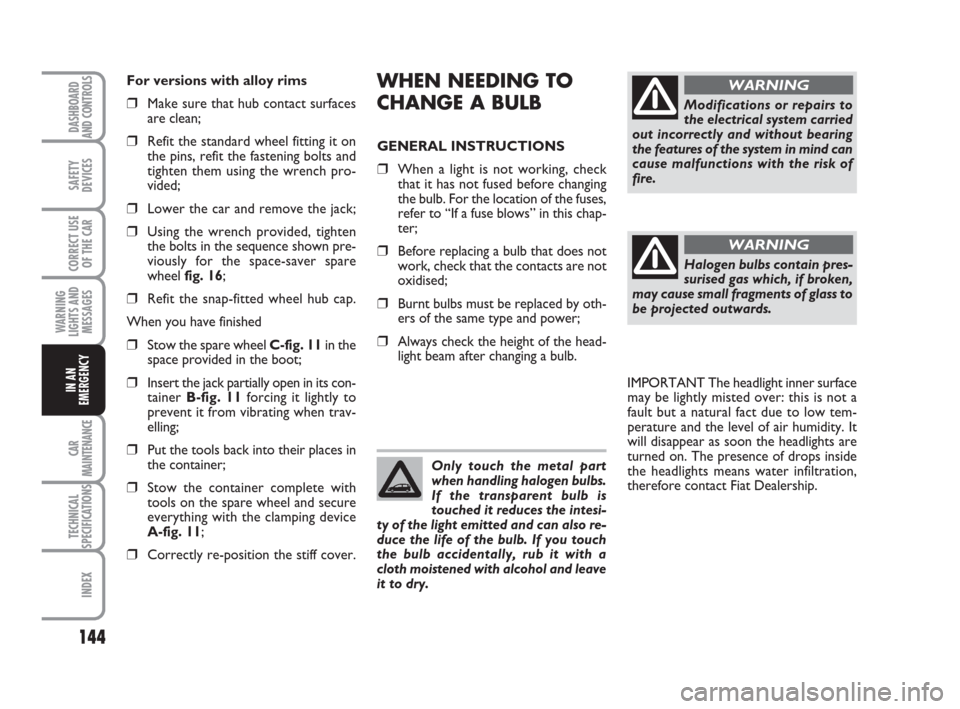
144
CAR
MAINTENANCE
TECHNICAL
SPECIFICATIONS
INDEX
DASHBOARD
AND CONTROLS
SAFETY
DEVICES
CORRECT USE
OF THE CAR
WARNING
LIGHTS AND
MESSAGES
IN AN
EMERGENCY
WHEN NEEDING TO
CHANGE A BULB
GENERAL INSTRUCTIONS
❒When a light is not working, check
that it has not fused before changing
the bulb. For the location of the fuses,
refer to “If a fuse blows” in this chap-
ter;
❒Before replacing a bulb that does not
work, check that the contacts are not
oxidised;
❒Burnt bulbs must be replaced by oth-
ers of the same type and power;
❒Always check the height of the head-
light beam after changing a bulb. For versions with alloy rims
❒Make sure that hub contact surfaces
are clean;
❒Refit the standard wheel fitting it on
the pins, refit the fastening bolts and
tighten them using the wrench pro-
vided;
❒Lower the car and remove the jack;
❒Using the wrench provided, tighten
the bolts in the sequence shown pre-
viously for the space-saver spare
wheel fig. 16;
❒Refit the snap-fitted wheel hub cap.
When you have finished
❒Stow the spare wheel C-fig. 11in the
space provided in the boot;
❒Insert the jack partially open in its con-
tainer B-fig. 11forcing it lightly to
prevent it from vibrating when trav-
elling;
❒Put the tools back into their places in
the container;
❒Stow the container complete with
tools on the spare wheel and secure
everything with the clamping device
A-fig. 11;
❒Correctly re-position the stiff cover.
Modifications or repairs to
the electrical system carried
out incorrectly and without bearing
the features of the system in mind can
cause malfunctions with the risk of
fire.
WARNING
Halogen bulbs contain pres-
surised gas which, if broken,
may cause small fragments of glass to
be projected outwards.
WARNING
Only touch the metal part
when handling halogen bulbs.
If the transparent bulb is
touched it reduces the intesi-
ty of the light emitted and can also re-
duce the life of the bulb. If you touch
the bulb accidentally, rub it with a
cloth moistened with alcohol and leave
it to dry.
IMPORTANT The headlight inner surface
may be lightly misted over: this is not a
fault but a natural fact due to low tem-
perature and the level of air humidity. It
will disappear as soon the headlights are
turned on. The presence of drops inside
the headlights means water infiltration,
therefore contact Fiat Dealership.
133-160 idea GB 1 ed 10-07-2008 8:30 Pagina 144
Page 160 of 210
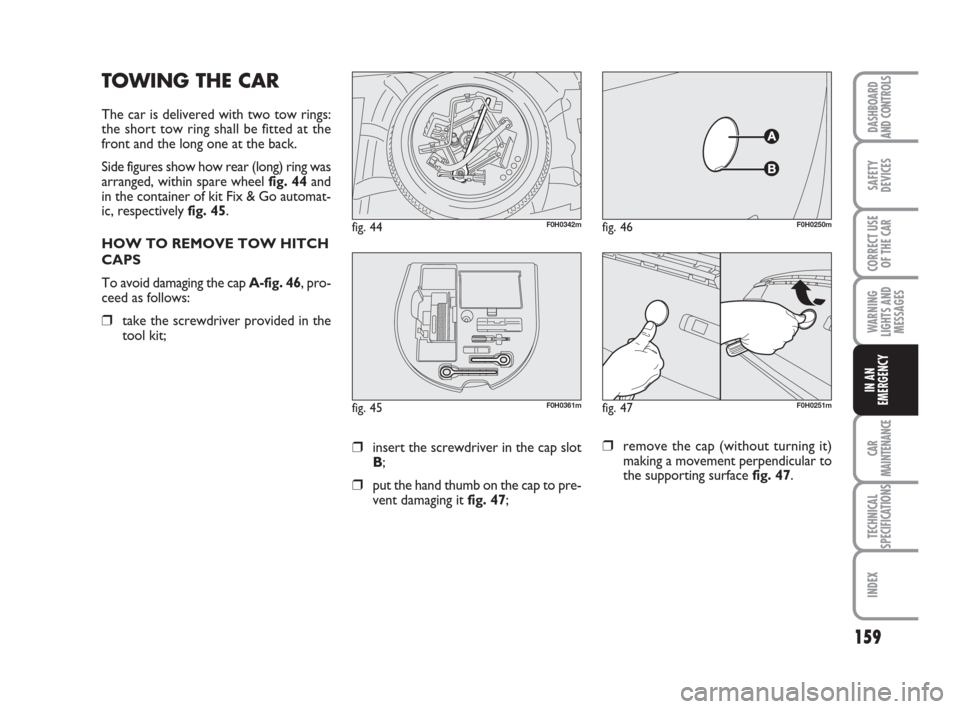
159
CAR
MAINTENANCE
TECHNICAL
SPECIFICATIONS
INDEX
DASHBOARD
AND CONTROLS
SAFETY
DEVICES
CORRECT USE
OF THE CAR
WARNING
LIGHTS AND
MESSAGES
IN AN
EMERGENCY
TOWING THE CAR
The car is delivered with two tow rings:
the short tow ring shall be fitted at the
front and the long one at the back.
Side figures show how rear (long) ring was
arranged, within spare wheel fig. 44 and
in the container of kit Fix & Go automat-
ic, respectively fig. 45.
HOW TO REMOVE TOW HITCH
CAPS
To avoid damaging the cap A-fig. 46, pro-
ceed as follows:
❒take the screwdriver provided in the
tool kit;
fig. 46F0H0250m
fig. 47F0H0251m
❒insert the screwdriver in the cap slot
B;
❒put the hand thumb on the cap to pre-
vent damaging it fig. 47;
fig. 44F0H0342m
fig. 45F0H0361m
❒remove the cap (without turning it)
making a movement perpendicular to
the supporting surface fig. 47.
133-160 idea GB 1 ed 10-07-2008 8:30 Pagina 159
Page 161 of 210
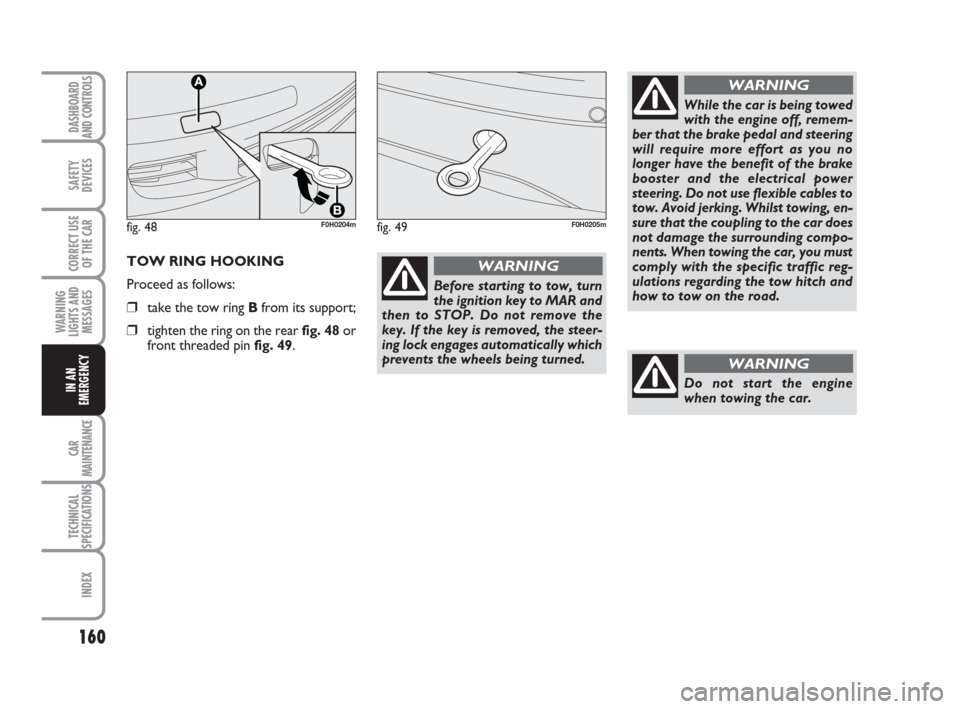
160
CAR
MAINTENANCE
TECHNICAL
SPECIFICATIONS
INDEX
DASHBOARD
AND CONTROLS
SAFETY
DEVICES
CORRECT USE
OF THE CAR
WARNING
LIGHTS AND
MESSAGES
IN AN
EMERGENCY
TOW RING HOOKING
Proceed as follows:
❒take the tow ring Bfrom its support;
❒tighten the ring on the rear fig. 48 or
front threaded pin fig. 49.
fig. 48F0H0204mfig. 49F0H0205m
Before starting to tow, turn
the ignition key to MAR and
then to STOP. Do not remove the
key. If the key is removed, the steer-
ing lock engages automatically which
prevents the wheels being turned.
WARNING
While the car is being towed
with the engine off, remem-
ber that the brake pedal and steering
will require more effort as you no
longer have the benefit of the brake
booster and the electrical power
steering. Do not use flexible cables to
tow. Avoid jerking. Whilst towing, en-
sure that the coupling to the car does
not damage the surrounding compo-
nents. When towing the car, you must
comply with the specific traffic reg-
ulations regarding the tow hitch and
how to tow on the road.
WARNING
Do not start the engine
when towing the car.
WARNING
133-160 idea GB 1 ed 10-07-2008 8:30 Pagina 160
Page 163 of 210
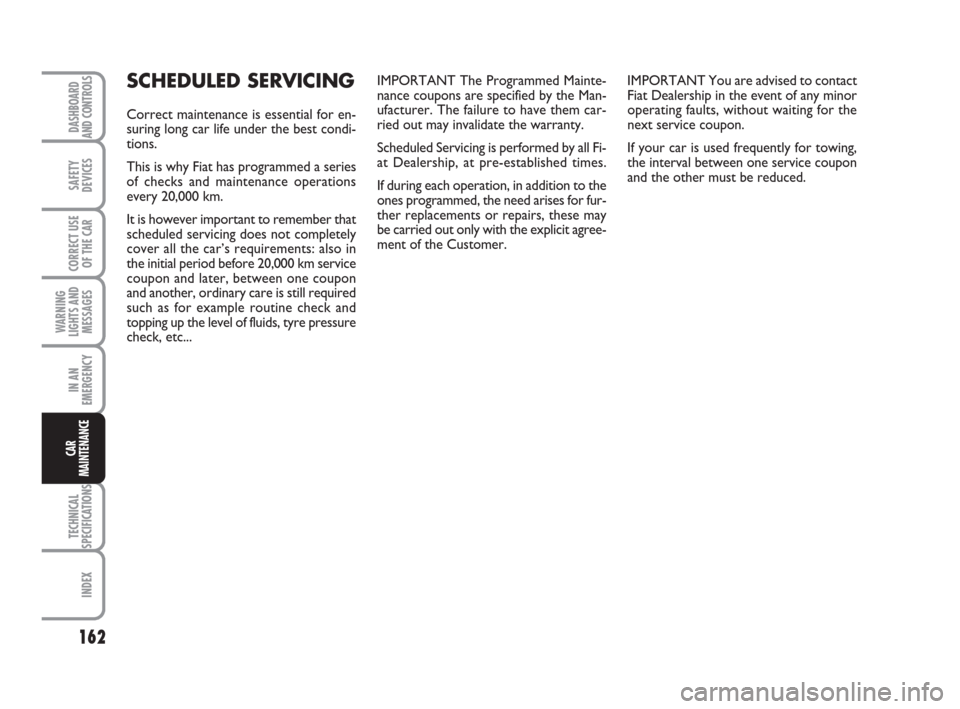
162
TECHNICAL
SPECIFICATIONS
INDEX
DASHBOARD
AND CONTROLS
SAFETY
DEVICES
CORRECT USE
OF THE CAR
WARNING
LIGHTS AND
MESSAGES
IN AN
EMERGENCY
CAR
MAINTENANCE
SCHEDULED SERVICING
Correct maintenance is essential for en-
suring long car life under the best condi-
tions.
This is why Fiat has programmed a series
of checks and maintenance operations
every 20,000 km.
It is however important to remember that
scheduled servicing does not completely
cover all the car’s requirements: also in
the initial period before 20,000 km service
coupon and later, between one coupon
and another, ordinary care is still required
such as for example routine check and
topping up the level of fluids, tyre pressure
check, etc...IMPORTANT The Programmed Mainte-
nance coupons are specified by the Man-
ufacturer. The failure to have them car-
ried out may invalidate the warranty.
Scheduled Servicing is performed by all Fi-
at Dealership, at pre-established times.
If during each operation, in addition to the
ones programmed, the need arises for fur-
ther replacements or repairs, these may
be carried out only with the explicit agree-
ment of the Customer.IMPORTANT You are advised to contact
Fiat Dealership in the event of any minor
operating faults, without waiting for the
next service coupon.
If your car is used frequently for towing,
the interval between one service coupon
and the other must be reduced.
161-180 idea GB 1 ed 10-07-2008 8:30 Pagina 162
Page 167 of 210
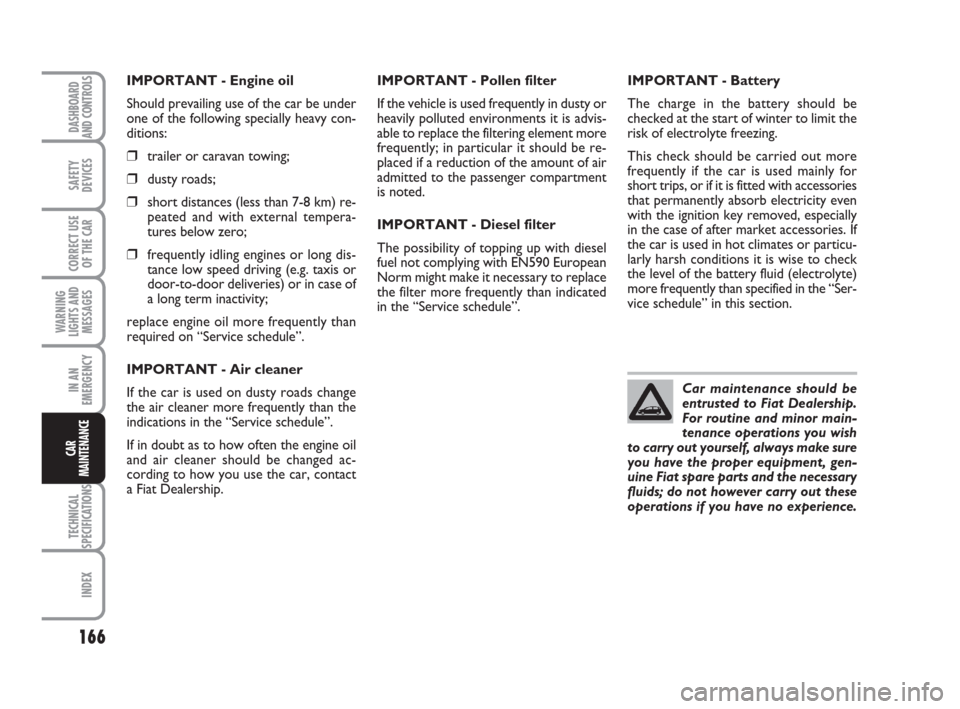
166
TECHNICAL
SPECIFICATIONS
INDEX
DASHBOARD
AND CONTROLS
SAFETY
DEVICES
CORRECT USE
OF THE CAR
WARNING
LIGHTS AND
MESSAGES
IN AN
EMERGENCY
CAR
MAINTENANCE
IMPORTANT - Engine oil
Should prevailing use of the car be under
one of the following specially heavy con-
ditions:
❒trailer or caravan towing;
❒dusty roads;
❒short distances (less than 7-8 km) re-
peated and with external tempera-
tures below zero;
❒frequently idling engines or long dis-
tance low speed driving (e.g. taxis or
door-to-door deliveries) or in case of
a long term inactivity;
replace engine oil more frequently than
required on “Service schedule”.
IMPORTANT - Air cleaner
If the car is used on dusty roads change
the air cleaner more frequently than the
indications in the “Service schedule”.
If in doubt as to how often the engine oil
and air cleaner should be changed ac-
cording to how you use the car, contact
a Fiat Dealership.IMPORTANT - Pollen filter
If the vehicle is used frequently in dusty or
heavily polluted environments it is advis-
able to replace the filtering element more
frequently; in particular it should be re-
placed if a reduction of the amount of air
admitted to the passenger compartment
is noted.
IMPORTANT - Diesel filter
The possibility of topping up with diesel
fuel not complying with EN590 European
Norm might make it necessary to replace
the filter more frequently than indicated
in the “Service schedule”.IMPORTANT - Battery
The charge in the battery should be
checked at the start of winter to limit the
risk of electrolyte freezing.
This check should be carried out more
frequently if the car is used mainly for
short trips, or if it is fitted with accessories
that permanently absorb electricity even
with the ignition key removed, especially
in the case of after market accessories. If
the car is used in hot climates or particu-
larly harsh conditions it is wise to check
the level of the battery fluid (electrolyte)
more frequently than specified in the “Ser-
vice schedule” in this section.
Car maintenance should be
entrusted to Fiat Dealership.
For routine and minor main-
tenance operations you wish
to carry out yourself, always make sure
you have the proper equipment, gen-
uine Fiat spare parts and the necessary
fluids; do not however carry out these
operations if you have no experience.
161-180 idea GB 1 ed 10-07-2008 8:30 Pagina 166
Page 195 of 210
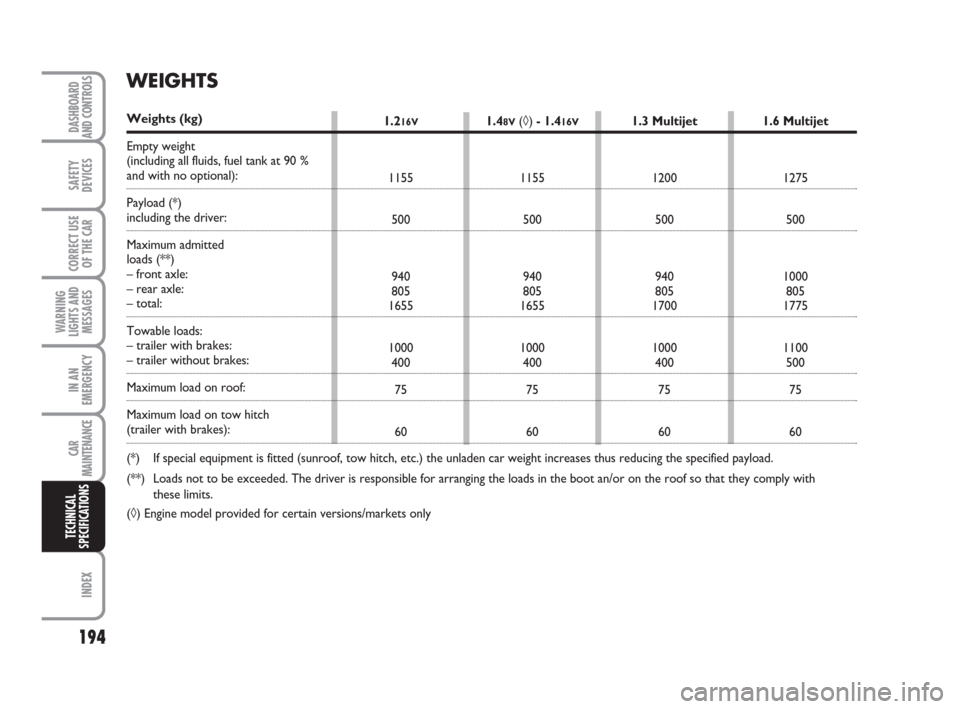
194
INDEX
DASHBOARD
AND CONTROLS
SAFETY
DEVICES
CORRECT USE
OF THE CAR
WARNING
LIGHTS AND
MESSAGES
IN AN
EMERGENCY
CAR
MAINTENANCE
TECHNICAL
SPECIFICATIONS
1.216V
1155
500
940
805
1655
1000
400
75
601.4
8V(◊) - 1.416V
1155
500
940
805
1655
1000
400
75
601.3 Multijet
1200
500
940
805
1700
1000
400
75
60
WEIGHTS
Weights (kg)
Empty weight
(including all fluids, fuel tank at 90 %
and with no optional):
Payload (*)
including the driver:
Maximum admitted
loads (**)
– front axle:
– rear axle:
– total:
Towable loads:
– trailer with brakes:
– trailer without brakes:
Maximum load on roof:
Maximum load on tow hitch
(trailer with brakes):
(*) If special equipment is fitted (sunroof, tow hitch, etc.) the unladen car weight increases thus reducing the specified payload.
(**) Loads not to be exceeded. The driver is responsible for arranging the loads in the boot an/or on the roof so that they comply with
these limits.
(◊) Engine model provided for certain versions/markets only1.6 Multijet
1275
500
1000
805
1775
1100
500
75
60
181-199 idea GB 1 ed 13-10-2008 12:12 Pagina 194
Page 204 of 210
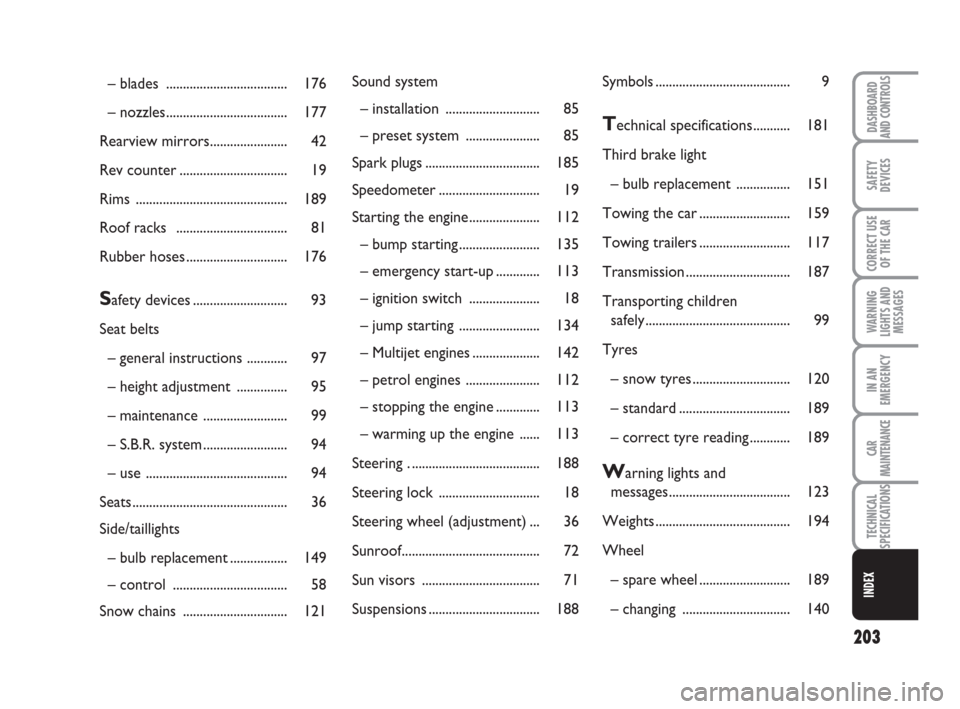
203
SAFETY
DEVICES
CORRECT USE
OF THE CAR
WARNING
LIGHTS AND
MESSAGES
IN AN
EMERGENCY
CAR
MAINTENANCE
TECHNICAL
SPECIFICATIONS
DASHBOARD
AND CONTROLS
INDEX
– blades .................................... 176
– nozzles.................................... 177
Rearview mirrors....................... 42
Rev counter ................................ 19
Rims ............................................. 189
Roof racks ................................. 81
Rubber hoses .............................. 176
Safety devices ............................ 93
Seat belts
– general instructions ............ 97
– height adjustment ............... 95
– maintenance ......................... 99
– S.B.R. system ......................... 94
– use .......................................... 94
Seats .............................................. 36
Side/taillights
– bulb replacement ................. 149
– control .................................. 58
Snow chains ............................... 121Symbols ........................................ 9
Technical specifications........... 181
Third brake light
– bulb replacement ................ 151
Towing the car ........................... 159
Towing trailers ........................... 117
Transmission ............................... 187
Transporting children
safely ........................................... 99
Tyres
– snow tyres ............................. 120
– standard ................................. 189
– correct tyre reading ............ 189
Warning lights and
messages.................................... 123
Weights ........................................ 194
Wheel
– spare wheel ........................... 189
– changing ................................ 140 Sound system
– installation ............................ 85
– preset system ...................... 85
Spark plugs .................................. 185
Speedometer .............................. 19
Starting the engine..................... 112
– bump starting ........................ 135
– emergency start-up ............. 113
– ignition switch ..................... 18
– jump starting ........................ 134
– Multijet engines .................... 142
– petrol engines ...................... 112
– stopping the engine ............. 113
– warming up the engine ...... 113
Steering . ...................................... 188
Steering lock .............................. 18
Steering wheel (adjustment) ... 36
Sunroof......................................... 72
Sun visors ................................... 71
Suspensions ................................. 188
200-208 idea GB 1 ed 13-10-2008 10:54 Pagina 203
Page 206 of 210
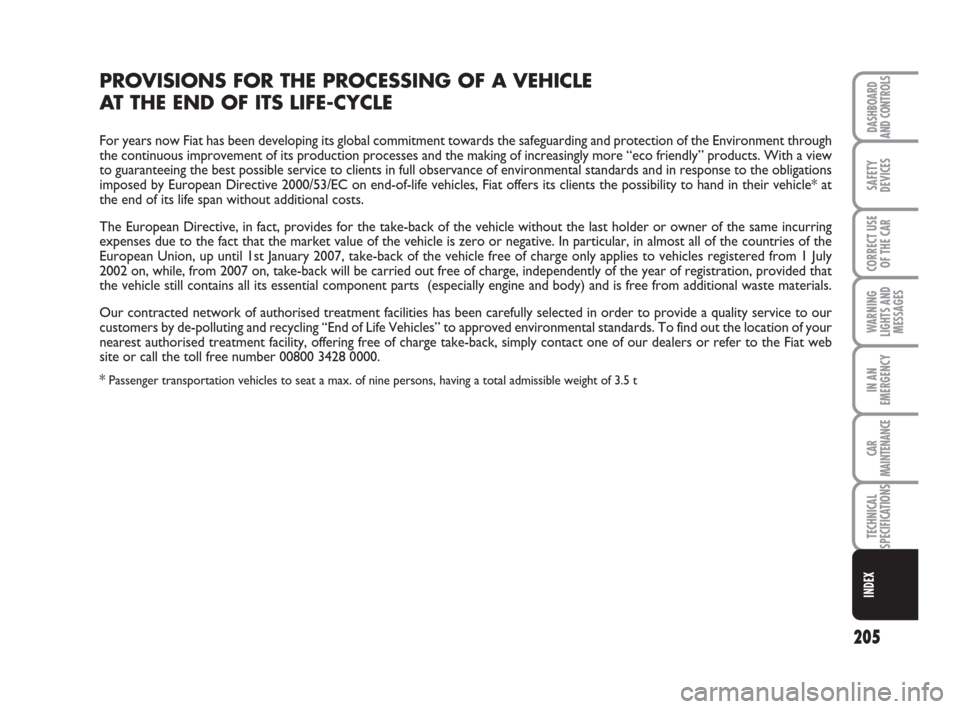
205
SAFETY
DEVICES
CORRECT USE
OF THE CAR
WARNING
LIGHTS AND
MESSAGES
IN AN
EMERGENCY
CAR
MAINTENANCE
TECHNICAL
SPECIFICATIONS
DASHBOARD
AND CONTROLS
INDEX
PROVISIONS FOR THE PROCESSING OF A VEHICLE
AT THE END OF ITS LIFE-CYCLE
For years now Fiat has been developing its global commitment towards the safeguarding and protection of the Environment through
the continuous improvement of its production processes and the making of increasingly more “eco friendly” products. With a view
to guaranteeing the best possible service to clients in full observance of environmental standards and in response to the obligations
imposed by European Directive 2000/53/EC on end-of-life vehicles, Fiat offers its clients the possibility to hand in their vehicle* at
the end of its life span without additional costs.
The European Directive, in fact, provides for the take-back of the vehicle without the last holder or owner of the same incurring
expenses due to the fact that the market value of the vehicle is zero or negative. In particular, in almost all of the countries of the
European Union, up until 1st January 2007, take-back of the vehicle free of charge only applies to vehicles registered from 1 July
2002 on, while, from 2007 on, take-back will be carried out free of charge, independently of the year of registration, provided that
the vehicle still contains all its essential component parts (especially engine and body) and is free from additional waste materials.
Our contracted network of authorised treatment facilities has been carefully selected in order to provide a quality service to our
customers by de-polluting and recycling “End of Life Vehicles” to approved environmental standards. To find out the location of your
nearest authorised treatment facility, offering free of charge take-back, simply contact one of our dealers or refer to the Fiat web
site or call the toll free number 00800 3428 0000.
*
Passenger transportation vehicles to seat a max. of nine persons, having a total admissible weight of 3.5 t
200-208 idea GB 1 ed 13-10-2008 10:54 Pagina 205